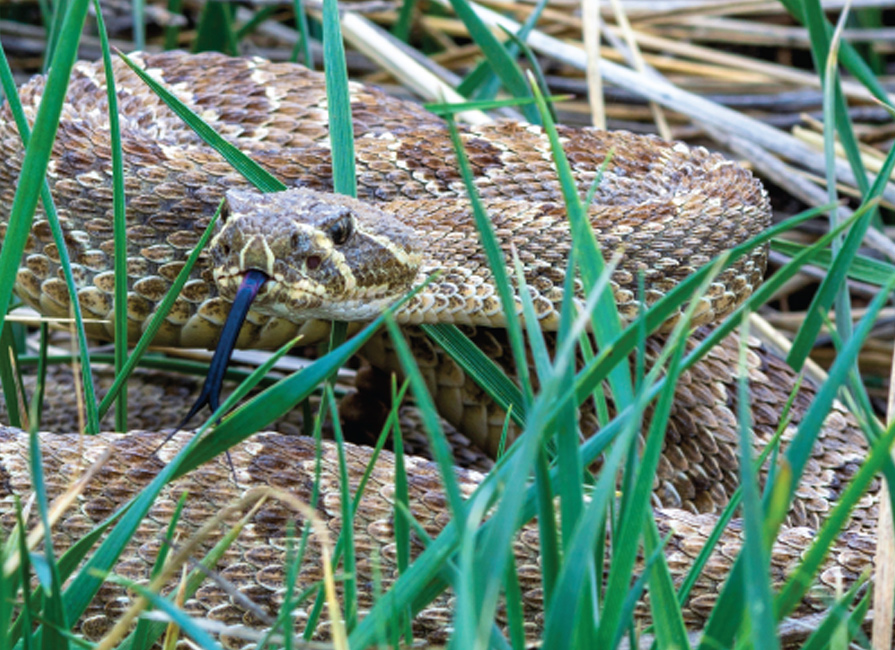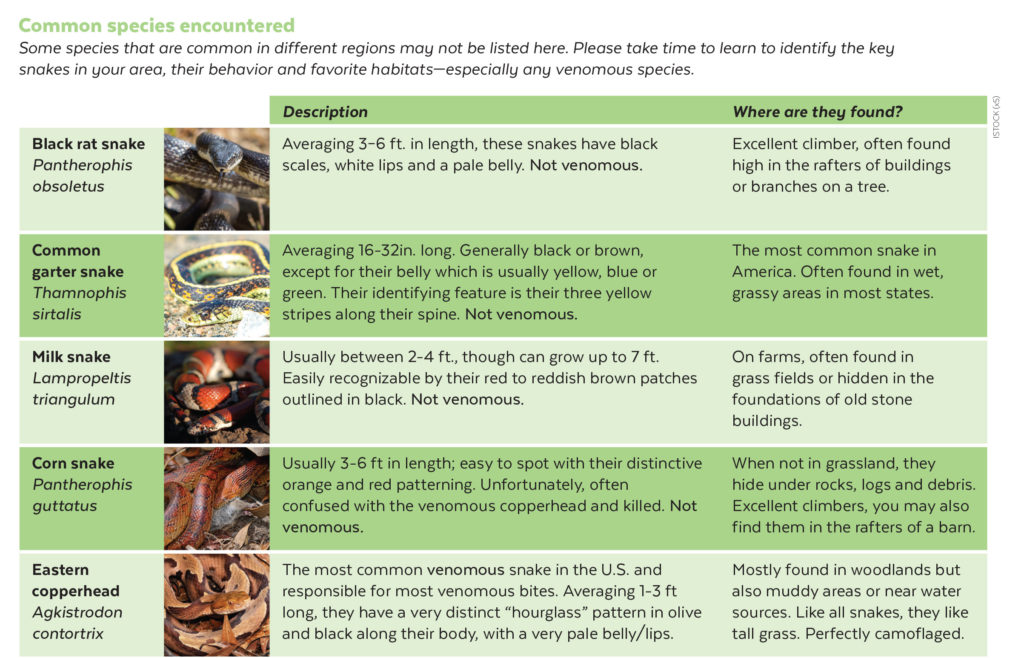One of the key attractions of our Certified Regenerative by AGW program is its practical…

Snake in The Grass
From a young age, we are often taught to fear snakes. What these animals need is not fear but respect. With a little research, snakes can be easily understood and tolerated with minimal anxiety.
Seeing a snake on your farm or ranch can be a frightening experience—particularly if you cannot identify the species and therefore do not know if the snake is going to harm you or your family. That being said, the vast majority of snakes in North America are not venomous. (Out of the 150 or so species of snakes in North America, only 20 species are venomous, and most are rarely sighted.) While some snake species can be harmful, most are highly beneficial to have on your farm or ranch. Provided these animals can be respected, they act as another member of the team, often helping to control rodent pests—and even other more harmful snake species.
Why be more snake-friendly?
Many species of snake act as a natural pest control. Different species of snake will have different natural diets, and so promoting snakes living on your land can provide a free pest-control service. For example, the common garter snake, one of the most common species in America, lives on a diet of flies and other insects. The corn snake will feed voraciously on mice and rats, while the common milk snake (like other species of kingsnake) will not only eat plenty of mice and rates, but other snakes, too—including venomous snakes. All the above species of snake are non-venomous and therefore present no significant danger to humans or livestock.
Tolerating snake species on your land can also help to deter larger predators around your livestock. Many American snakes, such as the bull snake and gopher snake, have evolved to mimic the skin patterns of the rattlesnake and so may discourage animals from coming closer.
Of course, this is not to say you should welcome snakes onto your property and let them run (or slither) wild! It is unwise to allow them free access to livestock housing, for example, so it is important to take steps to snake-proof key livestock areas—particularly when raising poultry or rabbits.
Snake behavior
To live safely alongside snakes, we first need to understand basic snake behavior.
Snakes are ectotherms, meaning they cannot regulate their own body heat. As a result, they often spend large portions of time basking, either in trees, on rocks, on sand banks or even on the roofs of houses/barns.
As a species, snakes are generally quite rational. They expend most of their energy on hunting purposes; as a result, they are very unlikely to attack a person unless they feel they have no other choice. Snakes generally only bite people when they are picked up, cornered, or stood on. Provided space and respect, the chances are the snake in question will leave you alone.
Snake-proof housing
While snakes perform an important role in controlling pests, we do not necessarily want to invite them into all areas of the farm! The objective is therefore to deter snakes from key areas of the farm and make these locations as undesirable and inhospitable as possible for any snakes.
Many non-venomous snakes, like the scarlet kingsnake, rat snake and gopher snake, are extremely useful in preying on rodents—and even venomous snakes. But they will also happily feed on chicks, eggs and rabbit kids, too. So, it is important not to give snakes an easy meal or they may become habitual predators.
It is impossible to prevent snakes from entering every livestock building but you should take steps to snake-proof housing and brooding areas where snakes are a known problem—particularly if you farm poultry or rabbits. While adult chickens can attack and even kill snakes, chicks and rabbit kids are highly vulnerable, as are fresh eggs. So, take particular care to snake-proof brooding areas, nesting boxes and egg collection areas.
If possible, plan to build any new housing on a hard standing or raised off the ground. Snakes can enter any hole the diameter of its head, so cover all possible openings with ¼” hardware cloth and caulk all smaller holes. Do not forget that some snake species are excellent climbers, so take time to locate any possible access points higher up.
Regularly clear areas around housing of tall grass and brush. Remove all debris located around or near housing that snakes can use as cover.
Remember: most snakes are usually first attracted by an abundance of small rodents, which in turn are likely to be feeding on livestock feed. So, it is important to take steps to prevent rodents from accessing grain storage areas and minimize grain spillages around the farm, clearing up any excess feed waste on a daily basis. Likewise, collect eggs daily and clear up all breakages.
Where snakes are a known problem, wear gloves, long-sleeves, long pants and high boots when walking or working in tall grass. Take extra care when moving wood piles, mobile housing or anything on the ground (think rock piles, straw bales, feed bags, old corrugated roofing, general debris and so on) that could provide cover.
What to do if you see a snake
Generally speaking, most snake species will not attack unless they feel provoked or unable to easily escape, so giving any snake a wide berth is absolutely essential.
If you are walking through long grass or moving livestock to areas with long grass, think about sweeping the area with a walking stick to clear out any snakes. Be particularly alert when walking through sandy or rocky areas where snakes may bask or when moving wood piles, mobile housing or anything that could provide cover.
If you do see any snake, staying at least three feet away will give you protection. Snakes cannot strike at a distance of more than half their body length; as the longest snake found in North America are around six feet, staying over three feet away will provide some safety.
If you do surprise a snake, stay calm and still, before backing away very slowly. The snake is likely to be more scared than you and, in most cases, it will be only too pleased to move away of its own accord.
If the worst happens and a snake bite occurs, go to your local emergency room as soon as possible. The doctors will need to administer the correct antivenom before the venom can show symptoms. Calling in advance will give the doctors the opportunity to ensure they have the correct antivenom at the facility or to direct you to another hospital.
Previous advice was to cut the snake bite to suck out venom or tie a tourniquet. This is no longer advised, as you may end up doing more damage than good.
Do not waste time trying to capture or kill the snake for identification. After a bite, the snake will likely retreat and be impossible to find. Instead, try to make a note of colors/markings that may help medics administer the correct antivenom. Take note of the time of the bite to help medics understand the progression of symptoms.
Finally, it is important to try to remain as calm as possible. Although sometimes easier said than done, remaining calm and still will help to slow the spread of the venom.

Summary
Having snakes on your land can offer a beneficial partnership, encouraging the natural regulation of vermin on the farm. Although the idea of encountering a venomous snake may be a worry, many species of venomous snake have not been seen in the country for many years. With regular work to minimize potentially snake-friendly habitats around barns and livestock housing and snake-proof any at-risk areas, it is possible to deter snakes from seeking a comfortable resting place—or coming back for an easy meal.
Johnathan David is Editor in Chief at Everything Reptiles, the authoritative reptile magazine. Visit everythingreptiles.com


